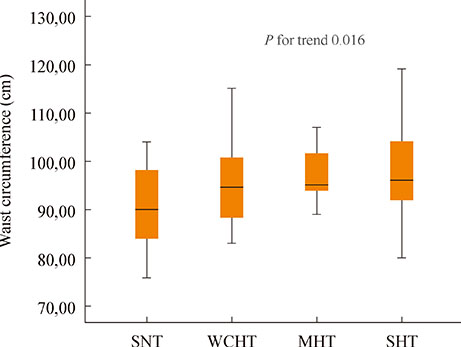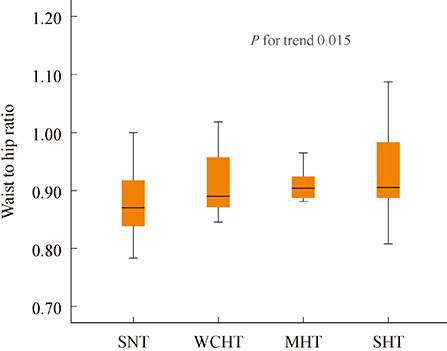Endocrinol Metab.
2013 Sep;28(3):199-206. 10.3803/EnM.2013.28.3.199.
The Impact of Different Anthropometric Measures on Sustained Normotension, White Coat Hypertension, Masked Hypertension, and Sustained Hypertension in Patients with Type 2 Diabetes
- Affiliations
-
- 1Division of Nephrology, Department of Internal Medicine, Konya Numune State Hospital, Konya, Turkey. afsarbrs@yahoo.com
- KMID: 1973824
- DOI: http://doi.org/10.3803/EnM.2013.28.3.199
Abstract
- BACKGROUND
Many studies have aimed to determine whether body mass index (BMI), waist circumference (WC), or waist to hip ratio (WHR) best predicts hypertension in diabetic patients, with conflicting results. However, no study has examined the specific relationship between these anthropometric parameters with sustained normotension (SNT), white coat hypertension (WCHT), masked hypertension (MHT), and sustained hypertension (SHT) based on office and ambulatory blood pressure (BP) measurements in these patients.
METHODS
Patients with newly diagnosed type 2 diabetes underwent the following procedures: history taking, measurements of anthropometric parameters, office and ambulatory BP measurements, physical examination, laboratory analysis, and random and 24-hour urine analysis.
RESULTS
In total, there were 65 dippers and 37 nondipper patients. None of the anthropometric parameters were different between the dippers and the nondippers. There were 25 patients with SNT, 32 with WCHT, seven with MHT, and 38 with SHT. A comparison of anthropometric parameters between these four groups of patients showed that WC (P=0.016) and WHR (P=0.015) were different among all groups. According to regression analysis, only BMI was independently related with MHT (odds ratio [OR], 1.373, P=0.022), whereas only WC has been associated with SHT (OR, 1.321, P=0.041).
CONCLUSION
Among anthropometric parameters, only WC and WHR were different in SNT, WCHT, MHT, and SHT in newly diagnosed patients with type 2 diabetes.
MeSH Terms
Figure
Cited by 1 articles
-
Brief Review of Articles in '
Endocrinology and Metabolism ' in 2013
Won-Young Lee
Endocrinol Metab. 2014;29(3):251-256. doi: 10.3803/EnM.2014.29.3.251.
Reference
-
1. Tuan NT, Adair LS, Stevens J, Popkin BM. Prediction of hypertension by different anthropometric indices in adults: the change in estimate approach. Public Health Nutr. 2010; 13:639–646.2. Thoenes M, Reil JC, Khan BV, Bramlage P, Volpe M, Kirch W, Bohm M. Abdominal obesity is associated with microalbuminuria and an elevated cardiovascular risk profile in patients with hypertension. Vasc Health Risk Manag. 2009; 5:577–585.3. Yusuf S, Hawken S, Ounpuu S, Dans T, Avezum A, Lanas F, McQueen M, Budaj A, Pais P, Varigos J, Lisheng L. INTERHEART Study Investigators. Effect of potentially modifiable risk factors associated with myocardial infarction in 52 countries (the INTERHEART study): case-control study. Lancet. 2004; 364:937–952.4. Anand SS, Islam S, Rosengren A, Franzosi MG, Steyn K, Yusufali AH, Keltai M, Diaz R, Rangarajan S, Yusuf S. INTERHEART Investigators. Risk factors for myocardial infarction in women and men: insights from the INTERHEART study. Eur Heart J. 2008; 29:932–940.5. Rankinen T, Kim SY, Perusse L, Despres JP, Bouchard C. The prediction of abdominal visceral fat level from body composition and anthropometry: ROC analysis. Int J Obes Relat Metab Disord. 1999; 23:801–809.6. Kannel WB, Cupples LA, Ramaswami R, Stokes J 3rd, Kreger BE, Higgins M. Regional obesity and risk of cardiovascular disease: the Framingham Study. J Clin Epidemiol. 1991; 44:183–190.7. Valdez R, Seidell JC, Ahn YI, Weiss KM. A new index of abdominal adiposity as an indicator of risk for cardiovascular disease. A cross-population study. Int J Obes Relat Metab Disord. 1993; 17:77–82.8. Almeida RT, Almeida MM, Araujo TM. Abdominal obesity and cardiovascular risk: performance of anthropometric indexes in women. Arq Bras Cardiol. 2009; 92:345–380.9. Afsar B. Comparison of demographic, clinical, laboratory parameters between patients with sustained normotension, white coat hypertension, masked hypertension, and sustained hypertension. J Cardiol. 2013; 61:222–226.10. Report of the Expert Committee on the Diagnosis and Classification of Diabetes Mellitus. Diabetes Care. 1997; 20:1183–1197.11. O'Brien E, Asmar R, Beilin L, Imai Y, Mallion JM, Mancia G, Mengden T, Myers M, Padfield P, Palatini P, Parati G, Pickering T, Redon J, Staessen J, Stergiou G, Verdecchia P. European Society of Hypertension Working Group on Blood Pressure Monitoring. European Society of Hypertension recommendations for conventional, ambulatory and home blood pressure measurement. J Hypertens. 2003; 21:821–848.12. Zhou J, Liu C, Shan P, Zhou Y, Xu E, Ji Y. Prevalence and distinguishing features of masked hypertension in type 2 diabetic patients. J Diabetes Complications. 2013; 27:82–86.13. Taylor RW, Jones IE, Williams SM, Goulding A. Evaluation of waist circumference, waist-to-hip ratio, and the conicity index as screening tools for high trunk fat mass, as measured by dual-energy X-ray absorptiometry, in children aged 3-19 y. Am J Clin Nutr. 2000; 72:490–495.14. Lean ME, Han TS, Morrison CE. Waist circumference as a measure for indicating need for weight management. BMJ. 1995; 311:158–161.15. Rexrode KM, Buring JE, Manson JE. Abdominal and total adiposity and risk of coronary heart disease in men. Int J Obes Relat Metab Disord. 2001; 25:1047–1056.16. Janssen I, Katzmarzyk PT, Ross R. Body mass index, waist circumference, and health risk: evidence in support of current National Institutes of Health guidelines. Arch Intern Med. 2002; 162:2074–2079.17. Pouliot MC, Després JP, Lemieux S, Moorjani S, Bouchard C, Tremblay A, Nadeau A, Lupien PJ. Waist circumference and abdominal sagittal diameter: best simple anthropometric indexes of abdominal visceral adipose tissue accumulation and related cardiovascular risk in men and women. Am J Cardiol. 1994; 73:460–468.18. Yalcin BM, Sahin EM, Yalcin E. Which anthropometric measurements is most closely related to elevated blood pressure? Fam Pract. 2005; 22:541–547.19. Cassani RS, Nobre F, Pazin-Filho A, Schmidt A. Relationship between blood pressure and anthropometry in a cohort of Brazilian men: a cross-sectional study. Am J Hypertens. 2009; 22:980–984.20. Panagiotakos DB, Chrysohoou C, Pitsavos C, Skoumas J, Lentzas Y, Katinioti A, Stefanadis C. Hierarchical analysis of anthropometric indices in the prediction of 5-year incidence of hypertension in apparently healthy adults: the ATTICA study. Atherosclerosis. 2009; 206:314–320.21. Redon J, Cea-Calvo L, Moreno B, Monereo S, Gil-Guillen V, Lozano JV, Marti-Canales JC, Llisterri JL, Aznar J, Fernandez-Perez C. Investigators of the PREV-ICTUS Study. Independent impact of obesity and fat distribution in hypertension prevalence and control in the elderly. J Hypertens. 2008; 26:1757–1764.22. Majane OH, Norton GR, Maseko MJ, Makaula S, Crowther N, Paiker J, Thijs L, Brooksbank R, Sareli P, Staessen JA, Woodiwiss AJ. The association of waist circumference with ambulatory blood pressure is independent of alternative adiposity indices. J Hypertens. 2007; 25:1798–1806.23. Frayn KN. Visceral fat and insulin resistance: causative or correlative? Br J Nutr. 2000; 83:Suppl 1. S71–S77.24. Canoy D, Luben R, Welch A, Bingham S, Wareham N, Day N, Khaw KT. Fat distribution, body mass index and blood pressure in 22,090 men and women in the Norfolk cohort of the European Prospective Investigation into Cancer and Nutrition (EPIC-Norfolk) study. J Hypertens. 2004; 22:2067–2074.25. Andalib A, Akhtari S, Rigal R, Curnew G, Leclerc JM, Vaillancourt M, Tardif JC. Determinants of masked hypertension in hypertensive patients treated in a primary care setting. Intern Med J. 2012; 42:260–266.26. Wang GL, Li Y, Staessen JA, Lu L, Wang JG. Anthropometric and lifestyle factors associated with white-coat, masked and sustained hypertension in a Chinese population. J Hypertens. 2007; 25:2398–2405.27. Trudel X, Brisson C, Larocque B, Milot A. Masked hypertension: different blood pressure measurement methodology and risk factors in a working population. J Hypertens. 2009; 27:1560–1567.28. Lurbe E, Invitti C, Torro I, Maronati A, Aguilar F, Sartorio A, Redon J, Parati G. The impact of the degree of obesity on the discrepancies between office and ambulatory blood pressure values in youth. J Hypertens. 2006; 24:1557–1564.
- Full Text Links
- Actions
-
Cited
- CITED
-
- Close
- Share
- Similar articles
-
- Higher Blood Pressure Variability in White Coat Hypertension; from the Korean Ambulatory Blood Pressure Monitoring Registry
- Clinical Significance of Home Blood Pressure and Its Possible Practical Application
- Clinical Manifestation of Ambulatory Blood Pressure Monitoring in Children and Adolescent with Hypertension
- Clinical Usefulness of 24-hour Ambulatory Blood Pressure Monitoring in Hypertensive Pregnancy
- Effects of White-coat Hypertension on Heart Rate Recovery and Blood Pressure Response during Exercise Test



